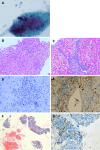Autoimmune hepatitis-primary biliary cholangitis overlap syndrome complicated by various autoimmune diseases: A case report
- PMID: 38464929
- PMCID: PMC10921307
- DOI: 10.12998/wjcc.v12.i6.1174
Autoimmune hepatitis-primary biliary cholangitis overlap syndrome complicated by various autoimmune diseases: A case report
Abstract
Background: Autoimmune hepatitis (AIH) and primary biliary cholangitis (PBC) are two common clinical autoimmune liver diseases, and some patients have both diseases; this feature is called AIH-PBC overlap syndrome. Autoimmune thyroid disease (AITD) is the most frequently overlapping extrahepatic autoimmune disease. Immunoglobulin (IgG) 4-related disease is an autoimmune disease recognized in recent years, characterized by elevated serum IgG4 levels and infiltration of IgG4-positive plasma cells in tissues.
Case summary: A 68-year-old female patient was admitted with a history of right upper quadrant pain, anorexia, and jaundice on physical examination. Laboratory examination revealed elevated liver enzymes, multiple positive autoantibodies associated with liver and thyroid disease, and imaging and biopsy suggestive of pancreatitis, hepatitis, and PBC. A diagnosis was made of a rare and complex overlap syndrome of AIH, PBC, AITD, and IgG4-related disease. Laboratory features improved on treatment with ursodeoxycholic acid, methylprednisolone, and azathioprine.
Conclusion: This case highlights the importance of screening patients with autoimmune diseases for related conditions.
Keywords: Autoimmune hepatitis; Autoimmune thyroid disease; Case report; Overlap syndrome; Primary biliary cholangitis; Primary sclerosing cholangitis.
©The Author(s) 2024. Published by Baishideng Publishing Group Inc. All rights reserved.
Conflict of interest statement
Conflict-of-interest statement: All the authors report no relevant conflicts of interest for this article.
Figures




Similar articles
-
[Autoimmune liver diseases and their overlap syndromes].Praxis (Bern 1994). 2006 Sep 6;95(36):1363-81. doi: 10.1024/1661-8157.95.36.1363. Praxis (Bern 1994). 2006. PMID: 16989180 Review. German.
-
Spectrum of Autoimmune Liver Disease and Real-World Treatment Experience from a Tertiary Care Hospital.J Clin Exp Hepatol. 2023 Mar-Apr;13(2):241-251. doi: 10.1016/j.jceh.2022.11.002. Epub 2022 Nov 10. J Clin Exp Hepatol. 2023. PMID: 36950480 Free PMC article.
-
Ulcerative colitis complicated by primary sclerosing cholangitis and autoimmune hepatitis overlap syndrome: a case report and literature review.Front Immunol. 2023 May 9;14:1132072. doi: 10.3389/fimmu.2023.1132072. eCollection 2023. Front Immunol. 2023. PMID: 37228618 Free PMC article. Review.
-
Chronic Liver Disease, Not Everything Is What It Seems: Autoimmune Hepatitis/Primary Biliary Cholangitis Overlap Syndrome.Cureus. 2024 Jan 4;16(1):e51630. doi: 10.7759/cureus.51630. eCollection 2024 Jan. Cureus. 2024. PMID: 38313999 Free PMC article.
-
The Spectrum of Autoimmune Liver Disorders, Clinical Presentation, and Autoantibodies in Patients From a Tertiary Care Center in Pakistan.Cureus. 2021 Nov 21;13(11):e19789. doi: 10.7759/cureus.19789. eCollection 2021 Nov. Cureus. 2021. PMID: 34820249 Free PMC article.
References
Publication types
LinkOut - more resources
Full Text Sources

